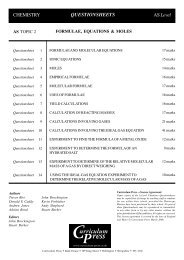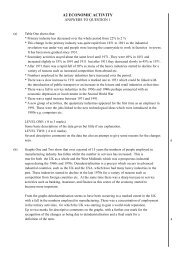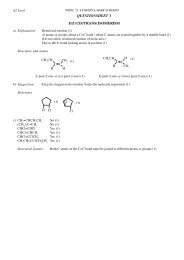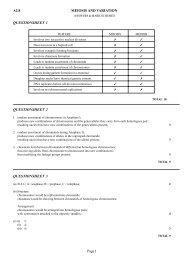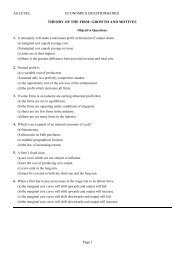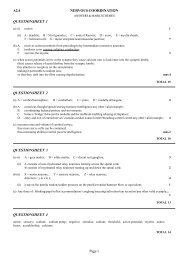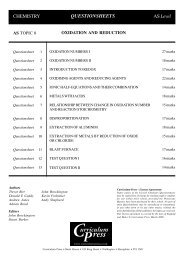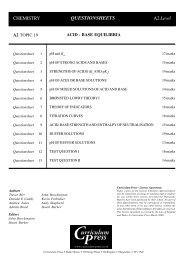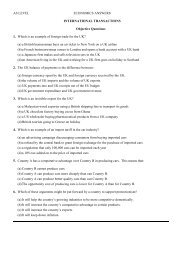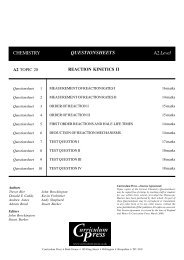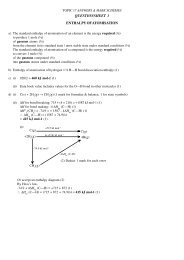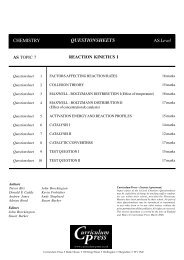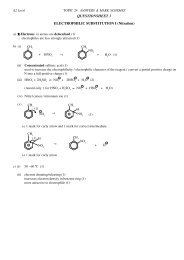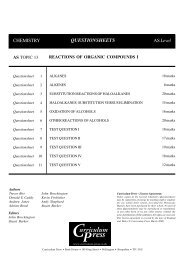HOMEOSTASIS A2.3
HOMEOSTASIS A2.3
HOMEOSTASIS A2.3
Create successful ePaper yourself
Turn your PDF publications into a flip-book with our unique Google optimized e-Paper software.
<strong>A2.3</strong><br />
<strong>HOMEOSTASIS</strong><br />
QUESTIONSHEET 1<br />
Do not<br />
write in<br />
margin<br />
Read through the following passage on homeostasis and then answer the questions.<br />
Homeostasis is the regulation of the internal environment within narrow limits. This gives the organism a<br />
degree of independence from the external environment. The regulation is carried out by negative and positive<br />
feedback mechanisms which when not required are damped. All living organisms possess some powers of<br />
homeostasis but homeostasis is best developed in birds and mammals.<br />
(a) (i)<br />
What do you understand by the term ‘internal environment’<br />
...........................................................................................................................................................................<br />
...........................................................................................................................................................................<br />
[2]<br />
(ii)<br />
Distinguish negative feedback control from positive feedback control.<br />
...........................................................................................................................................................................<br />
...........................................................................................................................................................................<br />
...........................................................................................................................................................................<br />
[2]<br />
(iii) Give one example of negative feedback control and one example of positive feedback control in<br />
mammals.<br />
Negative feedback control: .......................................................................................................................<br />
Positive feedback control: .........................................................................................................................<br />
[2]<br />
(iv) What do you understand by the term ‘damping’<br />
...........................................................................................................................................................................<br />
[1]<br />
(b)State one example of homeostatic control in each of the following organisms.<br />
Amoeba: ............................................................................................................................................................<br />
...........................................................................................................................................................................<br />
Marram grass: ....................................................................................................................................................<br />
...........................................................................................................................................................................<br />
Human: ..............................................................................................................................................................<br />
[3]<br />
TOTAL / 10
<strong>A2.3</strong><br />
<strong>HOMEOSTASIS</strong><br />
QUESTIONSHEET 2<br />
Describe the roles of the following in homeostasis in humans.<br />
Do not<br />
write in<br />
margin<br />
(a) Thermoreceptors: ..............................................................................................................................................<br />
...........................................................................................................................................................................<br />
...........................................................................................................................................................................<br />
....................................................................................................................................................................... [3]<br />
(b)Baroreceptors: ...................................................................................................................................................<br />
...........................................................................................................................................................................<br />
...........................................................................................................................................................................<br />
....................................................................................................................................................................... [3]<br />
(c) Glucoreceptors: .................................................................................................................................................<br />
...........................................................................................................................................................................<br />
...........................................................................................................................................................................<br />
....................................................................................................................................................................... [3]<br />
(d)Proprioceptors: ..................................................................................................................................................<br />
...........................................................................................................................................................................<br />
...........................................................................................................................................................................<br />
....................................................................................................................................................................... [3]<br />
TOTAL / 12
<strong>A2.3</strong><br />
<strong>HOMEOSTASIS</strong><br />
QUESTIONSHEET 3<br />
The graph below shows the changes in blood glucose concentration of a human subject over several hours. Prior<br />
to point A the subject had not eaten or drunk for a period of 8 hours. At point A the subject drank 200 cm 3 of a<br />
suspension containing 100 mg of glucose.<br />
12.0<br />
Do not<br />
write in<br />
margin<br />
Blood glucose concentration /m moles dm -3<br />
11.0<br />
10.0<br />
9.0<br />
8.0<br />
7.0<br />
6.0<br />
5.0<br />
4.0<br />
3.0<br />
0 1 2 3<br />
A<br />
B Time/hours C<br />
(a) (i) Comment on the blood glucose concentration prior to point A.<br />
...........................................................................................................................................................................<br />
...........................................................................................................................................................................<br />
....................................................................................................................................................................... [2]<br />
(ii) By reference to the graph determine the increase in blood glucose concentration between 1 hour and 1<br />
hour 30 minutes.<br />
....................................................................................................................................................................... [1]<br />
(b)With reference to the hormones involved, and to the biochemical changes occuring, explain the changes that<br />
occur in blood glucose concentration between A and B and B and C.<br />
A and B:.............................................................................................................................................................<br />
...........................................................................................................................................................................<br />
...........................................................................................................................................................................<br />
....................................................................................................................................................................... [3]<br />
B and C: .............................................................................................................................................................<br />
...........................................................................................................................................................................<br />
...........................................................................................................................................................................<br />
....................................................................................................................................................................... [3]<br />
TOTAL / 9
<strong>A2.3</strong><br />
<strong>HOMEOSTASIS</strong><br />
QUESTIONSHEET 4<br />
The following questions relate to regulation of the internal environment.<br />
Do not<br />
write in<br />
margin<br />
(a)(i)<br />
Distinguish between regulators and non-regulators and give one example of each.<br />
Regulators: ................................................................................................................................................<br />
...................................................................................................................................................................<br />
Example: ...................................................................................................................................................<br />
...................................................................................................................................................................<br />
Non-regulators: .........................................................................................................................................<br />
...................................................................................................................................................................<br />
Example: ...................................................................................................................................................<br />
...................................................................................................................................................................<br />
[4]<br />
(ii)<br />
Distinguish between exogenous and endogenous rhythms and give one example of each.<br />
Exogenous: ................................................................................................................................................<br />
...................................................................................................................................................................<br />
Example: ...................................................................................................................................................<br />
...................................................................................................................................................................<br />
Endogenous: ..............................................................................................................................................<br />
...................................................................................................................................................................<br />
Example: ...................................................................................................................................................<br />
...................................................................................................................................................................<br />
[4]<br />
(b)Long distance air travellers may feel extremely tired due to ‘jet lag’. Explain the physiological basis of ‘jet<br />
lag’.<br />
...........................................................................................................................................................................<br />
...........................................................................................................................................................................<br />
...........................................................................................................................................................................<br />
...........................................................................................................................................................................<br />
[4]<br />
TOTAL / 12
<strong>A2.3</strong><br />
<strong>HOMEOSTASIS</strong><br />
QUESTIONSHEET 5<br />
Do not<br />
write in<br />
margin<br />
Read through the following passage which refers to ADH and then fill in the spaces with the most appropriate<br />
word or words.<br />
The presence or absence of ADH in the blood is controlled by ..................................................... . Receptors in<br />
the .......................................... sense an increase in the ................................................ of the blood plasma and<br />
transmit nerve impulses to the ................................................................ which releases ADH into the blood by<br />
.................................... . ADH attaches onto target receptors on the ............................................................. cell<br />
membranes. It has the effect of making these membranes ................……..................which thus allows water to<br />
be............................................... .<br />
TOTAL /<br />
8
<strong>A2.3</strong><br />
<strong>HOMEOSTASIS</strong><br />
QUESTIONSHEET 6<br />
Do not<br />
write in<br />
margin<br />
The table below lists a number of homeostatic actions which are stimulated by certain hormones. Write the name<br />
of one hormone for each action in the appropriate box. Some hormones may be named more than once.<br />
Action<br />
Hormone<br />
Breakdown of glycogen in the liver<br />
Non-shivering thermogenesis<br />
Lowering of blood glucose concentration<br />
Acceleration of heart beat<br />
Reduction of water loss in urine<br />
Increase in flow of gastric juice<br />
Increase in antibody release by plasma cells<br />
TOTAL /<br />
7
<strong>A2.3</strong><br />
<strong>HOMEOSTASIS</strong><br />
QUESTIONSHEET 7<br />
The table below shows a typical daily water balance of a human body.<br />
Do not<br />
write in<br />
margin<br />
Water loss<br />
Water gain<br />
Total 2680cm 3 Total 2680cm 3<br />
Food 850cm 3 Faeces 130cm 3<br />
Drink 1450cm 3 Exhaled air 430cm 3<br />
Respiration (all cells) 380cm 3 Sweat 600cm 3<br />
Urine 1520cm 3<br />
(a) (i)<br />
Why must water gain be balanced by water loss<br />
...........................................................................................................................................................................<br />
...........................................................................................................................................................................<br />
[2]<br />
(ii) Select two of the above quantities which would increase during a period of vigorous exercise. In both<br />
cases explain why the values increase.<br />
Quantity l: .................................................................................................................................................<br />
Explanation: ..............................................................................................................................................<br />
............................................................................................................................................................... [2]<br />
Quantity 2: .................................................................................................................................................<br />
Explanation: ..............................................................................................................................................<br />
............................................................................................................................................................... [2]<br />
(iii) Suggest why only small volumes of concentrated urine are produced during very hot weather.<br />
...........................................................................................................................................................................<br />
...........................................................................................................................................................................<br />
...........................................................................................................................................................................<br />
[3]<br />
(b)Explain how the human controls water loss.<br />
...........................................................................................................................................................................<br />
...........................................................................................................................................................................<br />
...........................................................................................................................................................................<br />
...........................................................................................................................................................................<br />
...........................................................................................................................................................................<br />
[5]<br />
TOTAL / 14
<strong>A2.3</strong><br />
<strong>HOMEOSTASIS</strong><br />
QUESTIONSHEET 8<br />
Do not<br />
write in<br />
margin<br />
Distinguish between each of the following pairs:<br />
(a) Diabetes insipidus and diabetes mellitus.<br />
...........................................................................................................................................................................<br />
...........................................................................................................................................................................<br />
...........................................................................................................................................................................<br />
...........................................................................................................................................................................<br />
[4]<br />
(b)Homeostasis and haemostasis.<br />
...........................................................................................................................................................................<br />
...........................................................................................................................................................................<br />
...........................................................................................................................................................................<br />
...........................................................................................................................................................................<br />
[4]<br />
(c) Diuresis and deamination.<br />
...........................................................................................................................................................................<br />
...........................................................................................................................................................................<br />
...........................................................................................................................................................................<br />
...........................................................................................................................................................................<br />
[4]<br />
TOTAL / 12
<strong>A2.3</strong><br />
<strong>HOMEOSTASIS</strong><br />
QUESTIONSHEET 9<br />
Do not<br />
write in<br />
margin<br />
The table below shows the frequency at which the contractile vacuole of an Amoeba empties in various<br />
concentrations of sea water.<br />
Percentage concentration<br />
of sea water<br />
0 (pure water)<br />
10<br />
20<br />
30<br />
40<br />
50<br />
60<br />
70<br />
80<br />
Number of times contractile<br />
vacuole empties per hour<br />
95<br />
76<br />
69<br />
41<br />
21<br />
9<br />
2<br />
0<br />
0<br />
(a) What is the function of the contractile vacuole in Amoeba<br />
...........................................................................................................................................................................<br />
[1]<br />
(b) Explain how the contractile vacuole carries out its function.<br />
...........................................................................................................................................................................<br />
...........................................................................................................................................................................<br />
...........................................................................................................................................................................<br />
[2]<br />
(c) Explain the change in the rate of emptying of the contractile vacuole shown in the table.<br />
...........................................................................................................................................................................<br />
...........................................................................................................................................................................<br />
...........................................................................................................................................................................<br />
...........................................................................................................................................................................<br />
[4]<br />
TOTAL /<br />
7
<strong>A2.3</strong><br />
<strong>HOMEOSTASIS</strong><br />
QUESTIONSHEET 10<br />
Do not<br />
write in<br />
margin<br />
The diagram below illustrates the counter current principle as it operates in the loop of Henle and in the vasa<br />
recti. Figures refer to the NaCl concentration in millimoles dm -3 .<br />
renal capsule<br />
cortex<br />
outer<br />
medulla<br />
inner<br />
medulla<br />
collecting duct<br />
vasa recti<br />
interstitial<br />
fluid<br />
loop of Henle<br />
concentrated<br />
urine<br />
(a) (i)<br />
Explain the operation of the counter current principle in the loop of Henle.<br />
...........................................................................................................................................................................<br />
...........................................................................................................................................................................<br />
...........................................................................................................................................................................<br />
...........................................................................................................................................................................<br />
...........................................................................................................................................................................<br />
...........................................................................................................................................................................<br />
[4]<br />
(ii)<br />
What are the functions of the counter current principle in the loop of Henle.<br />
...........................................................................................................................................................................<br />
...........................................................................................................................................................................<br />
[2]<br />
(iii) What is the function of the counter current principle in the vasa recti.<br />
...........................................................................................................................................................................<br />
...........................................................................................................................................................................<br />
[2]<br />
TOTAL (Continued....)<br />
/
<strong>A2.3</strong><br />
<strong>HOMEOSTASIS</strong><br />
QUESTIONSHEET 10 CONTINUED<br />
Do not<br />
write in<br />
margin<br />
(b)What effects do the hormones ADH (antidiuretic hormone) and aldosterone have on the functions<br />
of the nephron<br />
ADH: .................................................................................................................................................................<br />
...........................................................................................................................................................................<br />
...........................................................................................................................................................................<br />
[2]<br />
Aldosterone: ......................................................................................................................................................<br />
...........................................................................................................................................................................<br />
...........................................................................................................................................................................<br />
...........................................................................................................................................................................<br />
[3]<br />
TOTAL / 13
<strong>A2.3</strong><br />
<strong>HOMEOSTASIS</strong><br />
QUESTIONSHEET 11<br />
Do not<br />
write in<br />
margin<br />
Read through the following account of control of kidney function and then answer the questions below.<br />
The presence or absence of ADH in the blood is controlled by negative feedback. Receptors in the hypothalamus<br />
sense an increase in the sodium ion concentration and osmolality (osmotic pressure) of the blood plasma and<br />
cause the release of ADH by neurosecretion. ADH attaches to target receptors on the collecting duct cell<br />
membranes. This makes the ducts permeable to water so allowing the reabsorption of water back to the blood.<br />
As a result the blood sodium ion concentration and osmolality fall as the blood volume and pressure rises. Thus<br />
the receptors are no longer stimulated and so ADH release is damped.<br />
(a) Explain what is meant by the following terms.<br />
(i) Negative feedback: ....................................................................................................................................<br />
...........................................................................................................................................................................<br />
....................................................................................................................................................................... [2]<br />
(ii) Damped: ....................................................................................................................................................<br />
....................................................................................................................................................................... [1]<br />
(iii) Neurosecretion: .........................................................................................................................................<br />
....................................................................................................................................................................... [1]<br />
(b) (i)<br />
Where is the hypothalamus<br />
............................................................................................................................................................... [1]<br />
(ii)<br />
State one function of the hypothalamus.<br />
............................................................................................................................................................... [1]<br />
(c) Explain why a rise in blood pressure will increase urine production.<br />
...........................................................................................................................................................................<br />
...........................................................................................................................................................................<br />
...........................................................................................................................................................................<br />
...........................................................................................................................................................................<br />
...........................................................................................................................................................................<br />
...........................................................................................................................................................................<br />
...........................................................................................................................................................................<br />
[4]<br />
TOTAL /<br />
10
<strong>A2.3</strong><br />
<strong>HOMEOSTASIS</strong><br />
QUESTIONSHEET 12<br />
The diagram below shows the female urinary system in ventral view.<br />
Do not<br />
write in<br />
margin<br />
posterior vena cava<br />
left kidney<br />
D. .........................<br />
A. .........................<br />
B. .........................<br />
bladder<br />
sphincter (X)<br />
C. .........................<br />
(a) (i) Label A,B, C, and D on the diagram. [4]<br />
(ii)<br />
State one way in which the anatomy of the male urinary system differs from that of the female.<br />
...........................................................................................................................................................................<br />
[1]<br />
(b)The kidneys produce urine as a result of carrying out their functions. State the two main functions of the<br />
kidneys.<br />
1. ........................................................................................................................................................................<br />
[1]<br />
2. ........................................................................................................................................................................<br />
[1]<br />
(c) What is the function of the sphincter muscle at X<br />
...........................................................................................................................................................................<br />
[1]<br />
TOTAL /<br />
8
<strong>A2.3</strong><br />
<strong>HOMEOSTASIS</strong><br />
QUESTIONSHEET 13<br />
In each of the following questions only one of the four responses is correct. In each case indicate the correct<br />
response by ringing around A, B, C or D.<br />
Do not<br />
write in<br />
margin<br />
(a) In the formation of urine the largest volume of water is reabsorbed from...<br />
A. The ascending limbs of the loops of Henle.<br />
B. The collecting ducts.<br />
C. The proximal convoluted tubules.<br />
D. The distal convoluted tubules.<br />
[1]<br />
(b)The main nitrogenous excretory end product is...<br />
A. Urea in mammals and insects.<br />
B. Uric acid in birds and insects.<br />
C. Uric acid in mammals and insects.<br />
D. Ammonia in fish and mammals.<br />
[1]<br />
(c) In which of the following mammalian organs does the blood gain most urea<br />
A. Liver.<br />
B. Kidney.<br />
C. Spleen.<br />
D. Pancreas.<br />
[1]<br />
(d)Which of the following structures is lined by a transitional epithelium<br />
A. The urethra.<br />
B. The bladder.<br />
C. The renal capsules.<br />
D. The collecting ducts.<br />
[1]<br />
TOTAL /<br />
4
<strong>A2.3</strong><br />
<strong>HOMEOSTASIS</strong><br />
QUESTIONSHEET 14<br />
Do not<br />
write in<br />
margin<br />
The total blood volume of a human averages 60cm 3 per kilogramme of body weight, and the average glomerular<br />
filtration rate is 125cm 3 minute -l .<br />
(a) Calculate the total blood volume of a person who weighs 120kg. Show your working.<br />
Answer ................................. [2]<br />
(b)Calculate the volume of glomerular filtrate produced per day by this person. Show your working.<br />
Answer ................................. [2]<br />
(c) How many times each day will the person’s blood be filtered by the kidneys Show your working.<br />
Answer ................................. [2]<br />
(d)Though the glomerular filtration rate averages 125cm 3 min -l the rate of urine release from the kidneys is only<br />
about lcm 3 min -1 . Suggest how this difference in volumes is accomplished.<br />
...........................................................................................................................................................................<br />
...........................................................................................................................................................................<br />
...........................................................................................................................................................................<br />
[3]<br />
TOTAL /<br />
9
<strong>A2.3</strong><br />
<strong>HOMEOSTASIS</strong><br />
QUESTIONSHEET 15<br />
Do not<br />
write in<br />
margin<br />
The diagram below is of a nephron from a mammalian kidney.<br />
A. ..................................<br />
B. ..................................<br />
F. ..................................<br />
C. ..................................<br />
D. ..................................<br />
E. ..................................<br />
G. ..................................<br />
urine<br />
(a) (i) Label structures A, B, C, D, E, F and G on the diagram. [7]<br />
(ii) Comment on the permeability to water of structures C, E and G.<br />
C: ................................................................................................................................................................... [1]<br />
E: ................................................................................................................................................................... [1]<br />
G: ................................................................................................................................................................... [1]<br />
(b)(i) Name two substances actively reabsorbed from C.<br />
1: .................................................................................................................................................................... [1]<br />
2: .................................................................................................................................................................... [1]<br />
(ii) Name two substances actively secreted into F.<br />
1: .................................................................................................................................................................... [1]<br />
2: .................................................................................................................................................................... [1]<br />
(c) (i)<br />
Structure E has powerful active transport mechanisms for reabsorbing Na + and Cl - ions back into the<br />
surrounding tissue fluid. What is the purpose of this<br />
...........................................................................................................................................................................<br />
...........................................................................................................................................................................<br />
[2]<br />
(ii) Explain why the fluid concentration in G may remain the same as that in F<br />
...........................................................................................................................................................................<br />
...........................................................................................................................................................................<br />
...........................................................................................................................................................................<br />
[2]<br />
TOTAL /<br />
18
<strong>A2.3</strong><br />
<strong>HOMEOSTASIS</strong><br />
QUESTIONSHEET 16<br />
Do not<br />
write in<br />
margin<br />
Distinguish between each of the following pairs of structures.<br />
(a) Ureter and urethra.<br />
...........................................................................................................................................................................<br />
...........................................................................................................................................................................<br />
...........................................................................................................................................................................<br />
...........................................................................................................................................................................<br />
[4]<br />
b) Urinary bladder and gall bladder.<br />
...........................................................................................................................................................................<br />
...........................................................................................................................................................................<br />
...........................................................................................................................................................................<br />
...........................................................................................................................................................................<br />
[4]<br />
(c) Glomerulus and vasa recti.<br />
...........................................................................................................................................................................<br />
...........................................................................................................................................................................<br />
...........................................................................................................................................................................<br />
...........................................................................................................................................................................<br />
[4]<br />
(d)Afferent arteriole and efferent arteriole.<br />
...........................................................................................................................................................................<br />
...........................................................................................................................................................................<br />
...........................................................................................................................................................................<br />
...........................................................................................................................................................................<br />
[4]<br />
TOTAL /<br />
16
<strong>A2.3</strong><br />
<strong>HOMEOSTASIS</strong><br />
QUESTIONSHEET 17<br />
Do not<br />
write in<br />
margin<br />
Read through the following account of kidney function and then fill in the spaces with the most appropriate<br />
word or words.<br />
Blood enters the kidney under ................................... pressure through the ....................................... which<br />
branches, eventually into afferent arterioles. These give rise to capillaries which form ...................................<br />
which lie inside ....................................... capsules. Many of the small components of plasma are forced into<br />
the capsules by .............................................. . Large molecules, such as .............................................. cannot<br />
leave the blood and so exert an ........................................................ which will draw water from the filtrate<br />
back into the blood. The filtrate contains salts, excretory products such as ........................................., sugars<br />
such as ............................................... and amino acids. [9]<br />
TOTAL /<br />
9
<strong>A2.3</strong><br />
<strong>HOMEOSTASIS</strong><br />
QUESTIONSHEET 18<br />
Do not<br />
write in<br />
margin<br />
The diagram below shows the histological appearance of kidney tissue.<br />
renal<br />
capsule<br />
proximal<br />
convoluted tubule<br />
distal convoluted<br />
tubule<br />
brush border<br />
glomerulus<br />
capillaries<br />
basement<br />
membrane<br />
podocyte nuclei<br />
Give explanations for each of the following facts.<br />
(a) Proximal convoluted tubule cells have many mitochondria and bear microvilli on the luminar borders.<br />
...........................................................................................................................................................................<br />
...........................................................................................................................................................................<br />
...........................................................................................................................................................................<br />
...........................................................................................................................................................................<br />
[4]<br />
(b)The glomerular capillaries and inner surfaces of the renal capsule are made of specialised cells, called<br />
podocytes.<br />
...........................................................................................................................................................................<br />
...........................................................................................................................................................................<br />
...........................................................................................................................................................................<br />
[3]<br />
(c) Drinking coffee increases the volume of urine produced per unit time.<br />
...........................................................................................................................................................................<br />
...........................................................................................................................................................................<br />
...........................................................................................................................................................................<br />
[3]<br />
TOTAL /<br />
10
<strong>A2.3</strong><br />
(a) What is meant by homeostasis<br />
<strong>HOMEOSTASIS</strong><br />
QUESTIONSHEET 19<br />
Do not<br />
write in<br />
margin<br />
...........................................................................................................................................................................<br />
...........................................................................................................................................................................<br />
[2]<br />
(b)Explain how the following assist in homeostasis.<br />
(i)<br />
The contractile vacuole in Amoeba:<br />
...........................................................................................................................................................................<br />
...........................................................................................................................................................................<br />
...........................................................................................................................................................................<br />
[3]<br />
(ii) The elongated loop of Henle found in desert dwelling mammals:<br />
...........................................................................................................................................................................<br />
...........................................................................................................................................................................<br />
...........................................................................................................................................................................<br />
[3]<br />
(iii)<br />
The excretion of uric acid by adult insects:<br />
...........................................................................................................................................................................<br />
...........................................................................................................................................................................<br />
...........................................................................................................................................................................<br />
[3]<br />
(c) (i) Name the disease in humans in which large volumes of very dilute urine is produced.<br />
...........................................................................................................................................................................<br />
[1]<br />
(ii)What is the cause of this symptom<br />
...........................................................................................................................................................................<br />
[1]<br />
TOTAL / 13
<strong>A2.3</strong><br />
<strong>HOMEOSTASIS</strong><br />
QUESTIONSHEET 20<br />
Do not<br />
write in<br />
margin<br />
The table below refers to normal glomerular filtrate and to normal urine. If a feature is correct place a tick (3)<br />
in the box and if it is incorrect place a cross (7) in the box.<br />
Feature Glomerular filtrate Urine<br />
Contains glucose<br />
Does not contain amino acids<br />
Has a pH of 3.5<br />
Has the same composition as blood<br />
Never contains protein<br />
[5]<br />
TOTAL /<br />
5
<strong>A2.3</strong><br />
<strong>HOMEOSTASIS</strong><br />
QUESTIONSHEET 21<br />
Do not<br />
write in<br />
margin<br />
The pH of blood plasma must be maintained in the range 7.35 to 7.45. There are three main physiological ways<br />
of achieving this, one of which involves the kidney.<br />
(a) State two ways (not involving the kidney) by which the body controls blood pH.<br />
1: ........................................................................................................................................................................<br />
....................................................................................................................................................................... [2]<br />
2: ........................................................................................................................................................................<br />
....................................................................................................................................................................... [2]<br />
(b)Describe how the kidneys adjust the pH of the blood back to normal when it has become too acidic.<br />
...........................................................................................................................................................................<br />
...........................................................................................................................................................................<br />
...........................................................................................................................................................................<br />
...........................................................................................................................................................................<br />
...........................................................................................................................................................................<br />
....................................................................................................................................................................... [5]<br />
TOTAL / 9
<strong>A2.3</strong><br />
<strong>HOMEOSTASIS</strong><br />
QUESTIONSHEET 22<br />
Do not<br />
write in<br />
margin<br />
The table below shows the results of an investigation into the flow and composition of the fluids in a nephron.<br />
The positions of A, B, C, D, E and F are shown on the nephron diagram.<br />
Position Total flow rate Solute concentrations<br />
/cm 3 min -1 /g dm -3<br />
Protein Glucose Urea NaCl<br />
A 1200 76 1.1 0.3 18<br />
B 12 0.0 1.1 0.3 18<br />
C 20 0.0 0.0 1.6 18<br />
D 18 0.0 0.0 1.7 72<br />
E 18 0.0 0.0 1.7 16<br />
F 1.0 0.0 0.0 2.1 68<br />
B<br />
C<br />
E<br />
A<br />
F<br />
D<br />
(a) Explain the difference in flow rate between the points:<br />
(i) A and B.<br />
...........................................................................................................................................................................<br />
...........................................................................................................................................................................<br />
[1]<br />
(ii) C and F.<br />
...........................................................................................................................................................................<br />
...........................................................................................................................................................................<br />
[1]<br />
TOTAL (Continued....)<br />
/ 10
<strong>A2.3</strong><br />
<strong>HOMEOSTASIS</strong><br />
QUESTIONSHEET 22 CONTINUED<br />
Do not<br />
write in<br />
margin<br />
(b)Suggest reasons for each of the following.<br />
(i) The changes in urea concentration from A to F.<br />
...........................................................................................................................................................................<br />
...........................................................................................................................................................................<br />
...........................................................................................................................................................................<br />
[3]<br />
(ii) The change in salt concentration between C and D, and D and E.<br />
...........................................................................................................................................................................<br />
...........................................................................................................................................................................<br />
...........................................................................................................................................................................<br />
[3]<br />
(iii) The difference in protein concentration between A and B.<br />
...........................................................................................................................................................................<br />
...........................................................................................................................................................................<br />
[2]<br />
(iv) The difference in glucose concentration between B and C.<br />
...........................................................................................................................................................................<br />
[1]<br />
TOTAL /<br />
11
<strong>A2.3</strong><br />
<strong>HOMEOSTASIS</strong><br />
QUESTIONSHEET 23<br />
Do not<br />
write in<br />
margin<br />
(a) Are the following statements true or false Justify your answer.<br />
(i) The main function of the kidneys is to make urine.<br />
TRUE OR FALSE: .......................<br />
...........................................................................................................................................................................<br />
...........................................................................................................................................................................<br />
...........................................................................................................................................................................<br />
[3]<br />
(ii)A greater volume of urine is produced on a hot day than on a cold day.<br />
TRUE OR FALSE: .......................<br />
...........................................................................................................................................................................<br />
...........................................................................................................................................................................<br />
...........................................................................................................................................................................<br />
[3]<br />
(iii) The main excretory end product in reptiles and birds is uric acid.<br />
TRUE OR FALSE: .......................<br />
...........................................................................................................................................................................<br />
...........................................................................................................................................................................<br />
...........................................................................................................................................................................<br />
[3]<br />
(b)(i)<br />
Briefly explain what is meant by the term “renal dialysis”.<br />
...........................................................................................................................................................................<br />
...........................................................................................................................................................................<br />
...........................................................................................................................................................................<br />
[3]<br />
(ii) Under what circumstances would a kidney transplant be performed<br />
...........................................................................................................................................................................<br />
...........................................................................................................................................................................<br />
...........................................................................................................................................................................<br />
[3]<br />
TOTAL /<br />
15



